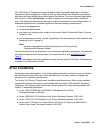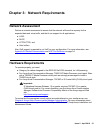
Other Network Considerations
Issue 5 April 2010 25
Reliability and Performance
All 1600 Series IP Telephones respond to a ping or traceroute message sent from the
DEFINITY
®
, MultiVantage™, Avaya Aura Communication Manager, or Avaya Aura
Communication Manager Branch system (formerly known as Avaya Distributed Office) or any
other network source. The telephones do not originate a ping or traceroute. The 1600 Series IP
Telephones offer and support “remote ping” and “remote traceroute.” The switch can instruct the
telephone to originate a ping or a traceroute to a specified IP address. The telephone carries
out that instruction and sends a message to the switch indicating the results. For more
information, see your switch administration documentation.
If applicable, the telephones test whether the network Ethernet switch port supports IEEE
802.1P/Q tagged frames by ARPing the router with a tagged frame. For more information, see
VLAN Considerations
on page 73. If your LAN environment includes Virtual LANs (VLANs),
your router must respond to ARPs for VLAN tagging to work properly.
QoS
For more information about the extent to which your network can support any or all of the QoS
initiatives, see your LAN equipment documentation. See QoS
on page 34 about QoS
implications for the 1600 Series IP Telephones.
All 1600 Series IP Telephones provide some detail about network audio quality. For more
information see, Network Audio Quality Display on
1600 Series IP Telephones on page 26.
IEEE 802.1P and 802.1Q
For more information about IEEE 802.1P and IEEE 802.1Q and the 1600 Series IP Telephones,
see IEEE 802.1
P and 802.1Q on page 34 and VLAN Considerations on page 73. Three bits of
the 802.1Q tag are reserved for identifying packet priority to allow any one of eight priorities to
be assigned to a specific packet.
● 7: Network management traffic
● 6: Voice traffic with less than 10ms latency
● 5: Voice traffic with less than 100ms latency
● 4: “Controlled-load” traffic for critical data applications
● 3: Traffic meriting “extra-effort” by the network for prompt delivery, for example, executive
e-mail
● 2: Reserved for future use
● 0: The default priority for traffic meriting the “best-effort” for prompt delivery of the network.
● 1: Background traffic such as bulk data transfers and backups


















